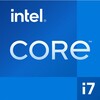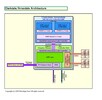Intel Core i7-12800H vs Intel Core i7-620M vs Intel Core i7-1260P
Intel Core i7-12800H
► remove from comparison
The Intel Core i7-12800H is a high-end mobile CPU for laptops based on the Alder Lake architecture. It was announced in early 2022 and offers 6 performance cores (P-cores, Golden Cove architecture) and 8 efficient cores (E-cores, Gracemont architecture). The P-cores support Hyper-Threading leading to 20 supported threads when combined with the E-cores. The clock rate ranges from 2.4 to 4.8 GHz on the performance cluster and 1.8 to3.7 GHz on the efficient cluster. The performance of the E-cores should be similar to old Skylake cores (compare to the Core i7-6920HQ). All cores can use up to 24 MB L3 cache. Compared to the 12900H, the 12800H is lower clocked and also features the full "Enterprise" set of vPro features (for remote management).
Features
The integrated memory controller supports various memory types up to DDR5-4800, DDR4-3200, LPDDR5-5200, and LPDDR4x-4267. The Thread Director (in hardware) can support the operating system to decide which thread to use on the performance or efficient cores for the best performance. For AI tasks, the CPU also integrates GNA 3.0 and DL Boost (via AVX2). Quick Sync in version 8 is the same as in the Rocket Lake CPUs and supports MPEG-2, AVC, VC-1 decode, JPEG, VP8 decode, VP9, HEVC, and AV1 decode in hardware. The CPU only supports PCIe 4.0 (x8 for a GPU and two x4 for SSDs).
The integrated graphics adapter is based on the Xe-architecture and offers 96 EUs (Execution Units) operating at up to 1.4 GHz.
Performance
The average 12800H in our database matches the Ryzen 9 6900HS and the Core i9-11900H in multi-thread performance. Which is fairly impressive, as of mid 2022.
Thanks to its decent cooling solution and a long-term CPU power limit of 70 W, the ZBook Studio 16 G9 is among the fastest laptops built around the 12800H that we know of. It can be about 70% faster in CPU-bound workloads than the slowest system featuring the same chip in our database, as of August 2023.
Power consumption
This Core i7 series chip has a "minimum assured" power consumption of 35 W, with 45 W being its Base power consumption. The maximum Intel-recommended Turbo power consumption sits at 115 W.
The i7-12800H is built with Intel's fourth-gen 10 nm process marketed as Intel 7 for average, as of early 2023, energy efficiency.
Intel Core i7-620M
► remove from comparison
The Intel Core i7-620M is a high end dual core CPU for laptops and clocks (due to the Turbo Mode) from 2.66 to 3.33 GHz. Each core is based on the Nehalem (Westmere) micro-architecture. Hyperthreading enables the Dual Core CPU to handle 4 threads at once (for a better usage of the pipeline). Therefore, the i7-620M is related to the other i5 and i3 dual core CPUs and not the quad-core i7 CPUs.
A feature of the new Core i7-620M is the integrated graphics card called Intel HD Graphics (GMA HD) and memory controller. Both are on a separate die that is still manufactured in 45nm whereas the CPU die is already manufactured in the new 32nm process.
The performance of the Core i7-620M is on average above the former fastest mobile dual core CPU, the Core 2 Duo T9900 / X9100. In our tests, just the single threaded rendering test in the Cinebench R10 benchmark scored less points. Even the mobile Core i7-720QM quad core is slower in many cases.
The 32nm cpu cores of the Westmere generation can also process some new instructions to accelerate AES encryptions. Compared to the slower i5 versions without AES features, the 3DMark Vantage Communication Score showed a significant increase with AES enabled CPUs.
The integrated Intel Graphics Media Accelerator HD (GMA HD) graphics card is clocked with 500-733 MHz and performs clearly faster than the old GMA 4500MHD. A GeForce 9400M (ION) should still be a bit faster (especially as Nvidia and ATI cards have a better driver support than Intel up to now).
The power consumption of 35 Watt TDP (max.) counts for the whole package and therefore it is clearly better than the 35 Watt TDP of the Core 2 Duo T-series (CPU alone).
The Core i7-620M should not be mistaken with the similar named but slower low voltage and ultra low voltage chips Core i7-620LM (2.13-2.93 GHZ, 25W) and Core i7-620UM (1.2-2.26 GHz, 18 W).
Intel Core i7-1260P
► remove from comparison
The Intel Core i7-1260P is an upper mid-range 28 W Alder Lake CPU designed for use in ultra-light laptops. It was announced in early 2022 and it features 4 performance cores as opposed to the 6 cores of the top-of-the-line i7-1280P (P-cores, Golden Cove architecture) mated to 8 efficient cores (E-cores, Gracemont architecture). The P-cores are Hyper-Threading-enabled for a total of 16 threads when combined with the E-cores. The clock speeds range from 2.1 GHz to 4.7 GHz for the performance cluster and 1.5 GHz to 3.4 GHz for the efficient cluster. The i7's shortcomings as compared to Intel Core i7-1270P include the marginally lower clock speeds and limited vPro feature set ("Essentials" tier only, not allowing for remote device management).
Architecture
The i7 is a continuation of Intel's efforts to use the ARM-developed big.LITTLE technology for its own benefit. A single "littile" Alder Lake core is supposed to be just as fast as a Skylake core (as found in the venerable Core i7-6700HQ among other options) which is six years old at this point. All of an Core i7-1260P's CPU cores enjoy access to 18 MB of L3 cache. The integrated memory controller supports various memory types up to LPDDR5-5200, DDR5-4800, LPDDR4x-4267 or DDR4-3200; Intel recommends using no more than 64 GB, for reference. Just like the other 12th Gen Intel Core processors, Intel Core i7-1260P comes with Thread Director which is a new functionality designed to help Windows 11 decide which cores to use for what workload for best performance and efficiency possible. Hardware acceleration of AI algorithms is supported via GNA 3.0 and DL Boost (via AVX2). PCI-Express 5.0 support has not found its way into Alder Lake P processors, so users will have to be content with PCI-Express 4.0 for the time being. Four PCI-Express 4 lanes allow for a read/write rate of up to 7.9 GB/s, provided a suitably fast NVMe SSD is used.
Please note this is not a user-replaceable CPU. It gets soldered permanently on to the motherboard (BGA1744 socket interface).
Performance
Multi-thread performance is most comparable to the Ryzen 7 5800U, Ryzen 7 PRO 5850U and also the Core i5-11260H. This makes the 1260P a great little CPU - one capable of punching above its weight.
Thanks to its decent cooling solution and a long-term CPU power limit of 35 W, the Asus ExpertBook B5 Flip B5602FBN is among the fastest laptops featuring the 1260P that we know of. It can be about 2 times as fast in CPU-bound workloads as the slowest system built around the same chip in our database (as of August 2023).
Graphics
The built-in graphics adapter in the form of the 96 EU Iris Xe running at up to 1.4 GHz has seemingly seen no change from what was built into certain Tiger Lake-UP3 processors, like a i7-1165G7. Which is hardly a downside as this iGPU is loaded with modern features such as AV1 video decoding capability and SUHD 4320p monitor support. Up to 4 monitors can be used simultaneously with this graphics adapter. Its gaming performance is bound to be tied to how high the Power Limits and how good the cooling solution of a laptop are; expect something close to NVIDIA's MX350 or in other words, acceptable framerates in most games when playing at 1080p / Medium settings. Fast RAM is a prerequisite for decent performance as the Iris Xe has to make do with no dedicated video memory. Last but not the least, we discovered that the GPU utilization when playing YouTube UHD 2160p60 videos is higher than it was with Tiger Lake chips.
Power consumption
The i7's base power consumption (also known as the default TDP or Power Limit 1) is 28 W, with 64 W being its maximum Intel-recommended Turbo power consumption (also known as the PL2). Its "Minimum Assured" power consumption sits at 20 W. All in all, an active cooling solution is a must for a CPU like this one here.
The i7-1260P is manufactured on Intel's fourth-gen 10 nm process marketed as Intel 7 for decent, as of late 2022, energy efficiency. Despite that, many 7 nm U-class AMD Ryzen 5000 parts are less power-hungry while being as fast (or even faster, depending on the workload) as the i7.
| Model | Intel Core i7-12800H | Intel Core i7-620M | Intel Core i7-1260P | ||||||||||||||||||||||||||||||||||||||||||||||||||||||||||||||||||||||||||||||||||||||||
| Codename | Alder Lake-H | Arrandale | Alder Lake-P | ||||||||||||||||||||||||||||||||||||||||||||||||||||||||||||||||||||||||||||||||||||||||
| Series | Intel Alder Lake-P | Intel Core i7 | Intel Alder Lake-P | ||||||||||||||||||||||||||||||||||||||||||||||||||||||||||||||||||||||||||||||||||||||||
| Series: Alder Lake-P Alder Lake-P |
|
|
| ||||||||||||||||||||||||||||||||||||||||||||||||||||||||||||||||||||||||||||||||||||||||
| Clock | 1800 - 4800 MHz | 2660 - 3333 MHz | 1500 - 4700 MHz | ||||||||||||||||||||||||||||||||||||||||||||||||||||||||||||||||||||||||||||||||||||||||
| L1 Cache | 1.2 MB | 1.1 MB | |||||||||||||||||||||||||||||||||||||||||||||||||||||||||||||||||||||||||||||||||||||||||
| L2 Cache | 11.5 MB | 512 KB | 10 MB | ||||||||||||||||||||||||||||||||||||||||||||||||||||||||||||||||||||||||||||||||||||||||
| L3 Cache | 24 MB | 4 MB | 18 MB | ||||||||||||||||||||||||||||||||||||||||||||||||||||||||||||||||||||||||||||||||||||||||
| Cores / Threads | 14 / 20 | 2 / 4 | 12 / 16 | ||||||||||||||||||||||||||||||||||||||||||||||||||||||||||||||||||||||||||||||||||||||||
| TDP | 45 Watt | 35 Watt | 28 Watt | ||||||||||||||||||||||||||||||||||||||||||||||||||||||||||||||||||||||||||||||||||||||||
| Technology | 10 nm | 32 nm | 10 nm | ||||||||||||||||||||||||||||||||||||||||||||||||||||||||||||||||||||||||||||||||||||||||
| max. Temp. | 100 °C | 105 °C | 100 °C | ||||||||||||||||||||||||||||||||||||||||||||||||||||||||||||||||||||||||||||||||||||||||
| Socket | BGA1744 | BGA1288, PGA988 | BGA1744 | ||||||||||||||||||||||||||||||||||||||||||||||||||||||||||||||||||||||||||||||||||||||||
| Features | DDR4-3200/LPDDR4x-4266/DDR5-4800/LPDDR5-5200 RAM, PCIe 4, Thread Director, DL Boost, GNA, Remote Platform Erase, MMX, SSE, SSE2, SSE3, SSSE3, SSE4.1, SSE4.2, AES, AVX, AVX2, FMA3, SHA | Turbo Boost, Hyper Threading, Enhanced Speedstep, integrierte GMA HD 500-733MHz, Dual Channel DDR3 memory controller | DDR4-3200/LPDDR4x-4266/DDR5-4800/LPDDR5-5200 RAM, PCIe 4, Thread Director, DL Boost, GNA, MMX, SSE, SSE2, SSE3, SSSE3, SSE4.1, SSE4.2, AVX, AVX2, BMI2, ABM, FMA, ADX, SMEP, SMAP, EIST, TM1, TM2, Hyper-Threading, Turbo, SST, AES-NI, RDRAND, RDSEED, SHA | ||||||||||||||||||||||||||||||||||||||||||||||||||||||||||||||||||||||||||||||||||||||||
| iGPU | Intel Iris Xe Graphics G7 96EUs ( - 1400 MHz) | Intel Iris Xe Graphics G7 96EUs ( - 1400 MHz) | |||||||||||||||||||||||||||||||||||||||||||||||||||||||||||||||||||||||||||||||||||||||||
| Architecture | x86 | x86 | x86 | ||||||||||||||||||||||||||||||||||||||||||||||||||||||||||||||||||||||||||||||||||||||||
| Announced | |||||||||||||||||||||||||||||||||||||||||||||||||||||||||||||||||||||||||||||||||||||||||||
| Manufacturer | ark.intel.com | ark.intel.com | ark.intel.com | ||||||||||||||||||||||||||||||||||||||||||||||||||||||||||||||||||||||||||||||||||||||||
| FSB | 2500 | ||||||||||||||||||||||||||||||||||||||||||||||||||||||||||||||||||||||||||||||||||||||||||
| Transistors | 382+177 Million | ||||||||||||||||||||||||||||||||||||||||||||||||||||||||||||||||||||||||||||||||||||||||||
| Die Size | 81+114 mm2 | ||||||||||||||||||||||||||||||||||||||||||||||||||||||||||||||||||||||||||||||||||||||||||
| $332 U.S. |
Benchmarks
Average Benchmarks Intel Core i7-12800H → 0% n=0
Average Benchmarks Intel Core i7-620M → 0% n=0
Average Benchmarks Intel Core i7-1260P → 0% n=0
* Smaller numbers mean a higher performance
1 This benchmark is not used for the average calculation













